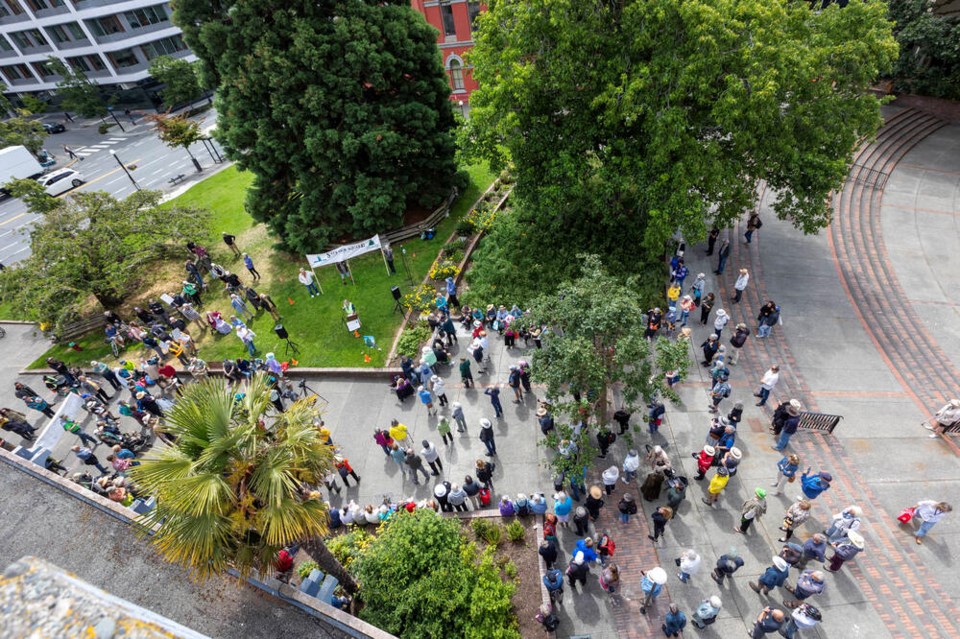It is clear that street disorder is an urgent community priority, and the funding for the plan must come from somewhere

A commentary by two members of Victoria council.
Last month, Victoria city council made the difficult decision to redeploy, for community safety priorities, some of the funds allocated toward two projects that have received grants from the province: facility upgrades at Royal Athletic Park (RAP) and infrastructure upgrades at Centennial Square.
Council chose to immediately act on a plan that is meant to address street disorder on Pandora Avenue and across downtown. This plan builds upon the Community Safety and Well-being Plan, and focuses on short-term results.
Street disorder is an urgent community priority, and the funding for the plan must come from somewhere. Council got creative and pulled together resources for a plan that can materially improve the safety and well-being of the community.
The funds will go toward innovative sheltering solutions (outside of downtown, residential areas and parks), improved enforcement of city bylaws, public works investments, street rehabilitation and other components of the plan.
Both the RAP and the Centennial projects will move ahead, albeit with revised scopes and budgets.
At RAP, $1.5 million of the $8.3 million grant will be redirected toward street disorder issues.
Most of the budget and plans remain intact for what are long-overdue upgrades at the city-owned facility, including accessibility upgrades, repairs to the grandstands and other improvements to spectator amenities.
At Centennial, the eastern portion of the project, where the sequoia tree is, will be indefinitely delayed.
The project will go ahead in the main part of the square, with a revised scope that still includes a new performance stage, a decorative and interactive water feature, accessibility upgrades and other infrastructure to support festivals, artisan markets and large events.
A key objective of the plan is to bring major festivals and community gatherings back to the square, including Jazzfest and Folkfest.
The artistic monoliths will be removed, carefully stored, and revisited at phase two of the project.
This revised scope allows for $2.5 million from the original project budget to be immediately redeployed toward Pandora and community safety initiatives.
The climate adaptation components of the plan will remain, including new trees, misting stations and a water feature that will help families stay cool during hot Victoria summers.
In terms of the sequoia, here is the bind in which council finds itself:
On one hand, the professional advice given to council by parks and engineering staff remains valid — that the root system of the tree poses medium-term risks to public safety, and that it is a matter of “when, not if” the tree will need to be removed. On the other hand, there has been an outpouring of love and support for the tree, and many people have questioned the rationale for removing it.
With this decision, the issue has been delayed indefinitely. When council eventually returns to the issue, we would propose that the city undertake an independent engineering and arborist analysis to confirm the risk level posed by the tree, and to chart a viable path ahead. It is imperative that we move forward in an evidence-based way.
The other bind that council finds itself in is the constant pressure to reduce street disorder, house the unhoused and address mental health and addictions issues in downtown and across the community.
The perpetual challenge is that local governments possess almost none of the tools, budget, mandate, staff or capacity to definitively solve these complex social issues. Cities across the country are now using an ever-expanding portion of their limited budgets to address problems that are supposed to be the responsibility of senior levels of government.
Redeploying funds from parks, livability and public realm improvements is one consequence of this downloading of responsibility to local governments.
That said, we recognize that the city must play a partnership role in addressing these complex issues and do its part to respond to community priorities. Indeed, the city has had some notable successes in addressing homelessness, including by hiring a parks relocation co-ordinator, who since 2023 has housed more than 40 individuals who were formerly sheltering in parks.
But it does not mean that Victoria and other cities should stop investing in the public realm. As Victoria grows and densifies, it is crucially important that local government continues to make investments in green spaces, parks, athletic facilities, street activation and livability, while holding senior governments to account to properly fund health and housing solutions that are principally their responsibility.
For now, a viable compromise has been struck that allows the city to respond to community safety priorities while continuing to invest in public infrastructure and amenities, using generous grants from the province.